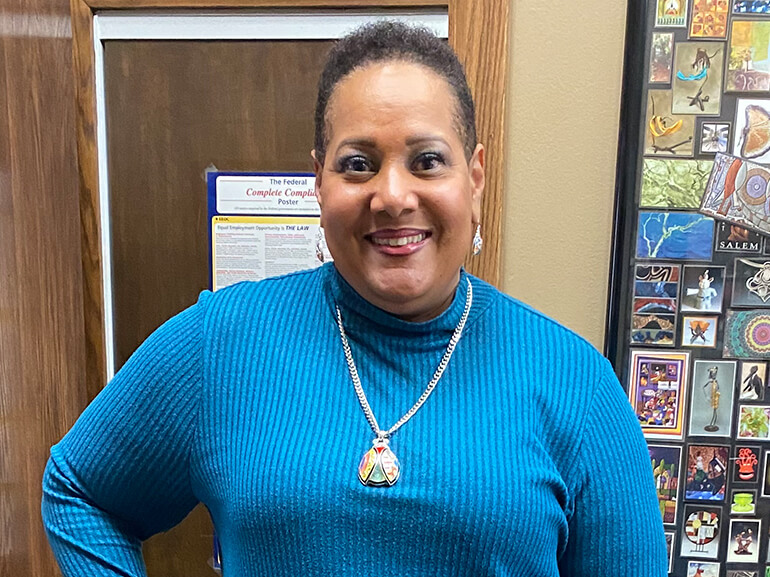Ronnie's story

Ronanita “Ronnie” Warren, 59, lives a busy life. She works full-time for the city of St. Louis as a payroll specialist and loves spending time with her mother, sisters and nieces.
Ronnie had been previously diagnosed with polymyositis, an uncommon inflammatory disease that causes muscle weakness affecting both sides of the body. Having this condition can make it difficult to climb stairs, rise from a seated position, lift objects or reach overhead. When she began feeling extremely fatigued earlier, she scheduled a virtual visit with her physician, who urged her to be tested for COVID-19. Unfortunately, Ronnie was feeling so weak that she wasn’t able to get to a local urgent care for testing.
Over the next few days, Ronnie’s conditioned worsened, making it difficult to walk and get out of bed. She finally had to call 911 and was taken to a local emergency room, where she tested positive for the virus. Hospital physicians ordered bloodwork for Ronnie and found that her creatine kinase (CK), an enzyme found in skeletal muscle, heart muscle and the brain, was over 29,000. When any of these tissues are damaged, they leak CK into the bloodstream. The normal CK is around 200, so Ronnie’s incredibly elevated level was a clear indicator of muscle injury or disease.
Ronnie was admitted to the hospital, but was quickly discharged after the physician felt she did not require any specific COVID-19 treatment. The virus had caused her existing polymyositis to flare, leaving her unable to stand or care for herself. After her primary care physician and rheumatologist discussed her case, they arranged for direct admission to the hospital. Ronnie was treated with intravenous immune globulin, a product made up of antibodies that helps fight infections, as well as methotrexate, an immunosuppressant that slows down the body’s immune system and helps reduce inflammation.
Ronnie responded well to the treatments and experienced a small improvement in her leg strength. Her physicians and therapists in the hospital recommended that Ronnie be transferred to SSM Health Rehabilitation Hospital – Richmond Heights to help her regain her strength and mobility.
Upon admission, Ronnie had no strength, was unable to stand or care for herself and was terrified of falling. Hospital staff used a hoyer lift, a mobility tool used to help people get out of bed or the bath without the assistance of another person, to transfer Ronnie from her bed to her wheelchair for the first few days. Ronnie’s primary rehabilitation goals were to be able to stand and perform her personal care independently. Her physician-led care team, which included physical and occupational therapists, created a plan to help Ronnie reach her goals.
From the very beginning, Ronnie took an active and engaged role in her recovery. In occupational therapy, therapists introduced adaptive equipment to help her dress and manage her personal care, which Ronnie picked up quickly. When she noticed her progress slowing, Ronnie advocated for herself to have some of her medications changed. These changes, combined with the intensive physical and occupational therapy, made Ronnie’s progress take off. “There was no slowing her down,” one of her therapists noted.
In physical therapy, Ronnie initially worked on using a transfer board to help her slide in and out of bed. A turning point in Ronnie’s rehabilitation came when physical therapists began helping her use a sit-to-stand trainer. Using a counter-weight mechanism, the sit-to-stand trainer provides standing and sitting support to enable safe, effective strengthening of weight-bearing muscles and assists in re-training.
Ronnie and her physical therapists also focused on building strength and stamina with a variety of exercises, including going up and down stairs, which Ronnie had not been able to do for two years. She eventually progressed to walking on a treadmill. “I needed someone to push me, not pamper me,” Ronnie said. “My therapists were focused and showed me techniques to help me improve. I am so grateful to them.”
The support of her mother, Carolyn, who participated in family training, was particularly helpful to keep Ronnie motivated and her spirits high. Ronnie and her mom spoke on the phone daily and Ronnie shared videos of her progress throughout her stay.
After three weeks at SSM Health Rehabilitation Hospital – Richmond Heights, Ronnie was ready to return home and continue her recovery at SSM Health Day Institute to work toward her new goals of returning to work. Ronnie says that she wants to make self-care a priority and focus on getting regular exercise and living a healthier lifestyle.
For individuals who need rehabilitation after an injury or illness, Ronnie says, “Don’t be afraid of therapy. Stay positive. The staff are professionals. Trust in them to get you to where you need to be. They will support you and be your number one cheerleader.”